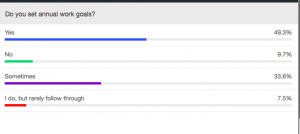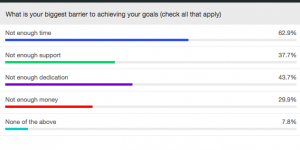Goal-setting is a common practice early in the year, but sticking to those goals requires action and can be difficult to achieve. If you have a career in government and want to advance to the next level, you have to set specific goals to accelerate your development.
GovLoop hosted an online training titled “How to Make Your Goals Stick in 2019” that tackled how to mold your goals around professional development opportunities, how to overcome obstacles to best complete your career goals, and which strategies and best practices to follow to better prioritize workforce development.
Julie Saad, Special Assistant to the Director, Potomac Service Center, U.S. Citizen and Immigration Services, Homeland Security Department, spoke at the training, and Emily Jarvis, Senior Online and Events Editor at GovLoop, moderated.
First, the audience was surveyed about whether they set work goals or not, with the majority answering yes or sometimes.

Saad then tackled the SMART way to set goals:
- Specific- You want your goals to be well defined and focused; you’re much more likely to accomplish them that way. Consider who is involved, what you want to accomplish, if there is a location where this is taking place, and your reason for pursuing the goal.
- Measurable- You want to establish criteria for measuring the progress that you’ve made, so that you’ll know when the goal is accomplished. “A goal without a measurable outcome is like a basketball game without a scoreboard,” Saad stated.
- Achievable- You want to establish a realistic, doable goal. For example, if your goal is to get a new job but you haven’t identified what you want to do or updated your resume yet, landing a job within a month is unrealistic. You might want to decrease the scope of the goal or broaden the time frame.
- Relevant- You should relate the goal to how it relates to your other long-term or short-term goals. If your goals aren’t cohesive, you might not be motivated to dedicate the time or energy to see them through.
- Time-based- If you anchor goals within a time frame, then you’ve already set your mind in motion to get going on that goal before the deadline.
The SMART model allows you to set more manageable goals, with greater structure. Instead of nebulously planning to achieve something someday, you can follow the SMART model, which imposes a time-based restraint on your goals and adds the element of measurability. It also helps you pinpoint exactly what you want to accomplish within a certain time-frame.
Once you have the SMART framework in place, you should develop an action plan, commit, and hold yourself accountable by tracking and reporting your progress and perhaps having people near you become aware of your goals. Remember to be kind to yourself and evaluate your progress as the year progresses. Be willing to adjust if necessary.
“Nothing is perfect, no one is perfect, and you’re going to encounter obstacles and challenges,” Saad said. “You want to plan for it, accept it and move forward. No matter what, you want to keep moving towards your goal.”
You also have to reflect on the goals you set, and ask yourself the following questions, both related to personal development and bigger picture development:
- What is the specific reason, purpose, or benefit of having the goal and accomplishing it?
- Why is the goal important to you?
- In what way will it enhance your professional development or further your career?
- How does the goal tie in to your other goals?
- How does it fit into your Individual Development Plan (IDP)?
“The idea here is that no goal should exist in an individual silo,” explained Saad.
Evaluate your existing skillset as well by honestly surveying your knowledge, skills, abilities and resources. Look at what you are already good at and see where those skills overlap with the steps you need to accomplish your goal.
The most important component of goal setting is being committed to your goals: “Your enthusiasm gets you started; your commitment takes you to the finish line,” Saad said.
One question asked during the training was “how do I measure success?” Saad acknowledged that it might be more difficult to track some goals, but there are qualitative and quantitative measures that could be used to track goal progress. As you outline steps in the action plan, the measure might become more apparent. For example, if you want to speak up in meetings, you might ask your manager to provide feedback over a certain time period based on what they see.
The audience also responded to their biggest barrier to achieving goals:

How do you work to achieve your goals? Let us know in the comments below.
Photo Credit: Estée Janssens on Unsplash





Great post! It’s shocking that only 7.5 percent of those polled said they rarely follow through on their goals. A problem I have is that the goals I set are too high and unachieveable so I will definitely use the SMART way when setting goals in the future.